Widescreen Weekend 2007 Program
|
Read more
at in70mm.com The 70mm Newsletter |
| Text by: Tony Earnshaw (NMM) & Thomas Hauerslev | Date: 13 March 2007 |
Thursday 15 March 2007 |
|
 19:30 "Casino Royale".
Filmed in:
35mm 4 perforations, 24 frames per second.
Principal photography in: Panavision System 35. Presented in:
Anamorphic
Panavision Super 35 with 6-track digital stereo
on the flat screen.
Aspect ratio: 2,39:1. Country of origin: United Kingdom. Production year:
2006.
World Premiere: 14.11.2006 Odeon Leicester Square, London England. 19:30 "Casino Royale".
Filmed in:
35mm 4 perforations, 24 frames per second.
Principal photography in: Panavision System 35. Presented in:
Anamorphic
Panavision Super 35 with 6-track digital stereo
on the flat screen.
Aspect ratio: 2,39:1. Country of origin: United Kingdom. Production year:
2006.
World Premiere: 14.11.2006 Odeon Leicester Square, London England. Screenplay by Neal Purvis, Paul Haggis and Robert Wade. Based upon Ian Fleming's history. Directed by Martin Campbell and produced by Barbara Broccoli. Original Music by David Arnold. Cinematography by Phil Meheux Daniel Craig (James Bond), Eva Green (Vesper Lynd), Mads Mikkelsen (Le Chiffre) and Judi Dench (M) In person is Mr. David Arnold (the film's composer) "Casino Royale" brings the James Bond franchise back to life with a new lead and a new style. Back to basics and close to the original text of the first book in the series, "Casino Royale" is a breath of fresh air and that rare thing, a critical and audience hit. Daniel Craig proves his worth in the lead as Bond is on the trail of Le Chiffre whom he must defeat in a high stakes poker game at the Casino Royale in Montenegro. This is the nastier side of Bond, evident in the first film, and a thrilling piece of filmmaking. |
More
in 70mm reading: Widescreen Weekend 2007 • Gallery: 2007 • Gallery: Rayton • WSW Home • Through the Years • The Best of WSW • Academy of the WSW • Creating the WSW • Planning the WSW • Projecting the WSW • Home of CINERAMA • Projecting CINERAMA Internet link: National Media Museum Bradford Film Festival Cinema Theatre Association Cinerama Adventure C.A. Productions 261 W. Verdugo Ave., #D Burbank, CA 91502 Phone: (818)843-1865 |
Friday 16 March 2007 |
|
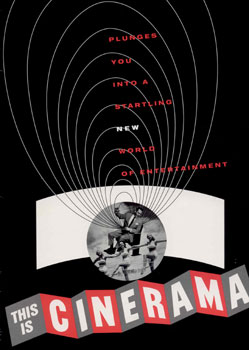 Developed by Fred Waller. Narrated by Lowell Thomas. Supervised by Michael Todd and Michael Todd Jr. Produced by Merian C. Cooper and Robert L. Bendick. Music by Cinerama Philharmonic Orchestra. Cinematography by Harry Squire. This is the original Cinerama feature which launched the widescreen era, here presented in a recently struck print in the original three-strip format, with seven-track stereo sound. There is no narrative, merely a variety of 'attractions': the famous rollercoaster ride is followed by a series of musical and travelogue episodes culminating in an aerial tour of America. More than a technological curio, it's a document of its era. What is Cinerama? Cinerama is a very complicated projection process with three projectors electronically locked together, showing three 35mm films side by side on the same curved screen, at the same time. Cinerama, very effectively creates an illusion of reality, by photographing an extreme wide-angle picture on three strips of film. Cinerama is shown on a large curved screen like Pictureville's. The curve is defined as being 146 degrees of a circle. The screen is geometrically the same size as the human eye, which when a spectator sits somewhere close to the center of the circle, looking at the middle of the screen, he’s having A First Person Experience. He’s having the sensation he is there, right in the middle of the action. The audience will feel a sensation of participation. Why does a Cinerama screen have to be deeply curved? ”If you photograph a cavalry of horses coming toward you and sweeping past, using conventional narrow angle lenses (and this includes CinemaScope), the camera never sees the sides of the horses. If this is now projected on a screen, even a wide curved one, wrapped around the audience, as the horses go off the screen, they all turn facing you and gallop sideways. This is a subtle effect, but the fact that you never see the sides of objects, destroys the participation effect - the sense of being in the middle of the action.” Brian O'Brien, Jr. about Cinerama. |
|
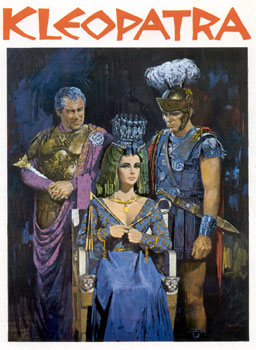 Screenplay by Joseph L. Mankiewicz, Ranald MacDougall and Sidney Buchman. Based upon histories by Plutarch. Suetonius. Appian, other ancient sources and "The Life and Times of Cleopatra," by C. M. Franzero. Directed by Mr. Mankiewicz and produced by Walter Wanger for 20th Century-Fox in Todd-AO. Elizabeth Taylor (Cleopatra), Richard Burton (Mark Antony), Rex Harrison (Julius Caesar), Hume Cronyn (Sosigenes) Martin Landau (Rutio) and Roddy McDowall (Octavian) A magnificent spectacle with a majestic, multitudinous cast, "Cleopatra" is arguably the biggest, brashest, most sprawling historical epic in modern movie history. Famously begun by Rouben Mamoulian and then shelved due to the illness of star Elizabeth Taylor, the film was re-started with a different director (Joe Mankiewicz) and a new cast that saw Richard Burton replace Keith Baxter and Rex Harrison take over from Peter Finch. The resulting motion picture is one of the all-time costume extravaganzas – a gigantic, OTT slice of Hollywoodery with the added sparkle of witnessing the Taylor/Burton dalliance explode into a full-blown love affair. Based on Carlo Mario Franzero’s biography, "Cleopatra" is more than just a lavish blockbuster; it is an example of runaway filmmaking at its most uncontrolled. What about Todd-AO? Todd-AO is 70mm film, projected on BIG screens. 70mm film guarantees rock-steady picture quality, thanks to the large image area and high frame rate. The negative is 4 times lager than standard 35mm film (1,85:1). The 70mm film format is often associated with the big epics and musicals from the 1960s. |
|
| 17:00 Reception for weekend delegates in the Kodak Gallery | |
|
18:00 Digital Cinema - is it worth it?
Demonstration. Digital presentation.
A forum with several clips on digital plus a chance to debate the
digital vs film argument. Darren Briggs from
Arts
Alliance will take part in the debate. The name of the event is 'DIGITAL CINEMA - IS IT WORTH IT?' Darren Briggs will be doing a PP presentation to give some background to digital cinema, combined with many digital clips to show its versatility and quality, and the fact that it caters to all existing cinema ratios 1.33, 1.85, 2.35 etc. We will also do a direct digital/film comparison of a recent movie with full 5.1 sound from both. The overall aim is to show that digital cinema can sit quite comfortably alongside film and that the quality of digital can be extremely high, well worth watching and allows for good presentation etc. It will be opened up to questions from the audience near the end as normal. All clips will be on the flat screen and we will do a 10min digital presentation on the curved screen during Cineramacana Sunday morning. |
|
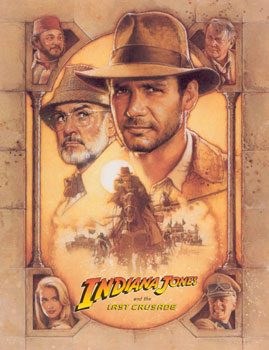 20:00 – 22:07 “Indiana Jones Last Crusade”
(2:07).
Filmed in: 35mm 4 perforations, 24 frames per second.
Principal photography in: Panavision. Presented in:
On the flat screen in Panavision 70mm with 6-track Dolby stereo with
split surrounds.
Aspect ratio: 2,21:1. Country of origin: USA. Production year:
1988.
World Premiere: 24.05.1989 New York, USA. 20:00 – 22:07 “Indiana Jones Last Crusade”
(2:07).
Filmed in: 35mm 4 perforations, 24 frames per second.
Principal photography in: Panavision. Presented in:
On the flat screen in Panavision 70mm with 6-track Dolby stereo with
split surrounds.
Aspect ratio: 2,21:1. Country of origin: USA. Production year:
1988.
World Premiere: 24.05.1989 New York, USA. Screenplay by George Lucas and Philip Kaufman. Directed by Steven Spielberg. Produced by George Lucas and Robert Watts. Music by John Williams. Cinematography by Douglas Slocombe. Film Editing by Michael Kahn. Harrison Ford (Indiana Jones), Sean Connery (Professor Henry Jones), Denholm Elliott (Dr. Marcus Brody), Alison Doody (Dr. Elsa Schneider) John Rhys-Davies (Sallah) and Julian Glover (Walter Donovan). Steven Spielberg pulled off a stroke of genius by casting Sean Connery as Indiana Jones’s crusty old dad. Connery steals the film – a tough call when the plotline has Indy criss-crossing the globe in search of the Holy Grail. Arguably the best of the series, Indiana Jones and the Last Crusade combines Arthurian myth with the 1930s Nazi milieu that made the first film so atmospheric. There is genuine chemistry between the two leads, Denholm Elliott supplies the comedy and Alison Doody makes for a suitably icy femme fatale. It is the setpieces, though, that remain in the memory: an aerial escape from a zeppelin, a white-knuckle tank chase and the final challenges of the film’s last reel – “Only the penitent man will pass”. Superb. In person is Mrs. Carin Anne Strohmaier who was Assistant Editor on "Indiana Jones Last Crusade". Carin-Anne Strohmaier, Executive Producer "Cinerama Adventure" on imdb.com. Carin-Anne has worked for the last 15 years at major studios as an assistant editor and associate editor. Among her numerous editing credits are, "Who Framed Roger Rabbit", "Back to the Future 2" and "Back to the Future 3", "The Rocketeer", "Forrest Gump", and "Contact" (several scenes in "Contact" were filmed in 65mm. VistaVision were used on many scenes in "Forrest Gump"). Her interest in film history documentaries is as strong as husband David's, as she has been acting as executive producer on this project, balancing creative duties with administrative on this 3 year project. |
|
Saturday 17 March 2007 |
|
 10:00 – 11:43 “Who Framed Roger Rabbit?” (1:43).
Filmed in:
35mm 4 perforations, 24 frames per second.
Principal photography in: Panavision widescreen. Presented in:
On the flat screen in 70mm with 6-track Dolby stereo with split
surrounds.
Aspect ratio: 1,85:1. Country of origin: USA. Production year:
1987.
World Premiere: 22.06.1988 Los Angels, USA. 10:00 – 11:43 “Who Framed Roger Rabbit?” (1:43).
Filmed in:
35mm 4 perforations, 24 frames per second.
Principal photography in: Panavision widescreen. Presented in:
On the flat screen in 70mm with 6-track Dolby stereo with split
surrounds.
Aspect ratio: 1,85:1. Country of origin: USA. Production year:
1987.
World Premiere: 22.06.1988 Los Angels, USA.Produced by: Don Hahn and Frank Marshall. Original Music by Alan Silvestri. Cinematography by: Dean Cundey. Film Editing by Arthur Schmidt. Directed by Robert Zemeckis Bob Hoskins (Eddie Valiant), Christopher Lloyd (Judge Doom), Joanna Cassidy (Dolores), Charles Fleischer (Roger Rabbit/Benny The Cab/Greasy/Psycho (voice)) and Kathleen Turner (Jessica Rabbit (voice)) In person is Mrs. Carin Anne Strohmaier Forget Mary Poppins and those Disney movies with cute penguins, this is where the fun is! The 1947 Hollywood film industry depends upon toons, indestructible cartoon characters. Roger Rabbit, one of the best, is distracted as he suspects his wife is unfaithful. The studio boss employs a private eye, Hoskins, to check up for him. One of the finest interactions between animation and live action. |
|
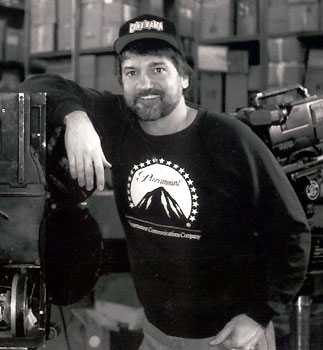 12:30 “Larger than Life” (1:00) Making of “Cinerama Adventure”.
Starring director Dave Strohmaier and producer Randy Gitsch 12:30 “Larger than Life” (1:00) Making of “Cinerama Adventure”.
Starring director Dave Strohmaier and producer Randy GitschPhoto: Dave Strohmaier, Director of full length documentary "Cinerama Adventure". David Strohmaier (Director-Editor-Writer) on imdb.com David Strohmaier has long been a film history buff, even before graduating from film school in the early 1970s and starting his career at Warner Brothers. As film and Avid editor for major studios such as Disney and 20th Century-Fox, he worked on many movies of the week, series pilots and episodes, including EPCOT documentaries at Disney and two CircleVision films made for their theme parks. Some of his more notable editing credits are "Northern Exposure", "Dangerous Minds", and three Alien Nation television movies. David also served as the historical consultant to Paul Allen's Seattle Cinerama theatre restoration project. His highly acclaimed 2003 documentary, "Cinerama Adventure", played in festivals across the country and has helped launch a whole new generation of Cinerama and widescreen enthusiasts. Martin Scorsese called it, "Wonderful." Michael Wilmington of the Chicago Tribune described it as "A fascinating chronicle," and Vanity Fair found "Cinerama Adventure" to be "Superb, full of humor, drama and genuine pathos, a surprisingly human tale." Besides directing, writing and editing "Cinerama Adventure", David edited many episodes of Columbia/Tri-Star TV's "Strong Medicine" (Lifetime series), "Don't Look Under The Bed" (Disney movie of the week ), "Kronenberg Chronicles" (pilot for FX), "New Fantasy Island" (ABC TV series), "Hotel Del Sol" (pilot for UPN), "The Pastor's Wife" (Fox/CBS pilot), "Sherlock Holmes Returns" (CBS movie), and "Stringer" (Showtime feature). |
|
 13:30 – 14:17 “Cinerama Adventure”
(1:37).
Filmed in: video, 25 frames per second.
Principal photography in: all sorts of video formats. Presented in:
On the flat screen in 35mm Dolby Digital.
Aspect ratio: 1,75: 1 - 1,85:1. Country of origin: USA. Production year:
2003.
World Premiere: 22.08.2003 - 28.08.2003, Arclight Hollywood, Los Angels, USA
(Academy Award qualifying run). 13:30 – 14:17 “Cinerama Adventure”
(1:37).
Filmed in: video, 25 frames per second.
Principal photography in: all sorts of video formats. Presented in:
On the flat screen in 35mm Dolby Digital.
Aspect ratio: 1,75: 1 - 1,85:1. Country of origin: USA. Production year:
2003.
World Premiere: 22.08.2003 - 28.08.2003, Arclight Hollywood, Los Angels, USA
(Academy Award qualifying run).The work-in-progress version was first shown on 7 August 1998 at the Hollywood Film Festival. Produced, written and edited by: Dave Strohmaier. Produced by: Randy Gitsch. Original Music by William Stromberg & John Morgan. Camera: Gerald Saldo and many others. Debbie Reynolds, Carroll Baker, Eli Wallach, Louis de Rochemont III, Michael Todd Jr., and Russ Tamblyn (as themselves). Complete Credits THE CINERAMA ADVENTURE is a 96 minute documentary celebrating the long lost three-camera three-projector cinematic process which thrilled millions of baby boomers around the globe in the 1950s and early 60s. Though abandoned in 1966, the Cinerama process still brings back fond, and sometimes passionate, memories to millions of Baby Boomers - of sweeping aerials, world travel, thrilling roller coaster rides, and other virtual reality experiences designed to lift the audience out of their theatre seats and into the action. Using unusual filmclips that have not been seen for over 40 years, "Cinerama Adventure" will take you behind the scenes for the human interest stories of the trials ans triumphs that were involved in making theses films: stories of hair rasing danger, international intrigue, critical injury and death. "Cinerama Adventure" is a dramatic and nostalgic look back at forgotten era in film history. Cinerama forever changed the way we see and hear movies and single handedly thrust the entire film industry into the wide screen stereo sound era that is with us to this day. Review I have seen "Cinerama Adventure" several times and enjoyed it very much. A feature lenght documentary about wide screen is very rare, and the Cinerama process certainly deserves this tribute. The amount of information collected for this production is amazing and much of it shows up in the form of interviews with the people behind the process as they experienced it. Having had the privileged to work with Mr. David Strohmaier on this production I am probably biased a bit, but "Cinerama Adventure" is a unique and VERY thrilling ride through memory lane about a world long gone. I was born in 1963 when Cinerama was nearly gone, and have never experienced the original buzz of the process. Having read about the format for 20 years and seen the process projected in Bradford and Dayton, I can only say that "Cinerama Adventure" gives the viewer a fantastic insight to Waller's Wonder and a taste of showmanship "three times the normal size". If you have the slightest interest in wide screen history - go see "Cinerama Adventure". A return engagement in Pictureville in a pristine 1.85:1, 35mm print with 5.1 Dolby SRD track. This is the recently retelecined theatrical version, instead of the Beta SP work picture which was screened in 2002. I highly recommend the film. Thomas Hauerslev, www.in70mm.com Visit the official website and on imdb.com |
|
 15:15 Lecture: Richard Gray from the
Cinema Theatres Association (30 min). 15:15 Lecture: Richard Gray from the
Cinema Theatres Association (30 min).
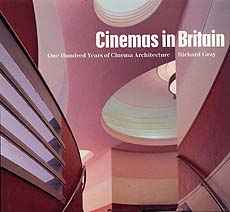 Richard
Gray was chairman of the Cinema Theatre Richard
Gray was chairman of the Cinema TheatreAssociation for many years and wrote a book called "Cinemas in Britain" Following last year’s introduction to the work of The Projected Picture Trust by Dion Hanson, we are delighted to welcome Richard Gray to talk about the work of the Cinema Theatre Association. The CTA was set up in 1967 by journalist Eric George, who wished to see more attention paid to the magnificent movie palaces of the 1920s and ‘30s, which were then starting to disappear from Britain’s towns and cities. Since then the CTA has widened its horizons to encompass the study of all cinema buildings, live theatres, music halls and those entertainment centres now used for bingo or other purposes. All aspects of cinemas and theatres are studied including architecture, decoration, film projection and stage facilities. Consideration is given to their study in terms of the history of entertainment, social history, industrial archaeology and architectural history. The Cinema Theatre Association The Cinema Theatre Association was started in 1967 by journalist Eric George, who wished to see more attention paid to the magnificent movie palaces of the Twenties and Thirties which were then starting to disappear from our towns and cities. Since then, the Association has widened its horizons to encompass the study of all cinema buildings, however humble, as well as live theatres, music halls and those entertainment buildings now in use as bingo halls or for other purposes. The Association campaigns for the preservation and continued use of cinemas and theatres for their original purpose. All aspects of cinemas and theatres are studied, including architecture, decoration, film projection and stage facilities. Consideration is given to their study in terms of the history of entertainment, social history, industrial archaeology and architectural history. |
|
 Written by James R. Webb. Produced by Bernard Smith. Original Music by Ken Darby and Alfred Newman. Cinematography by William H. Daniels, Milton R. Krasner, Charles Lang and Joseph LaShelle. Directed by John Ford, Henry Hathaway and George Marshall. Carroll Baker (Eve Prescott Rawlings), Lee J. Cobb (Marshal Lou Ramsey), Henry Fonda (Jethro Stuart), Gregory Peck (Cleve Van Valen), Debbie Reynolds (Lilith 'Lily' Prescott), James Stewart (Linus Rawlings), Eli Wallach (Charlie Gant) There are westerns and there westerns. "How the West Was Won" is something very special on the deep curved Cinerama screen and 7 track stereo sound. Thanks to generous contributions from many of the fans, we have been able to keep this excellent print going to present the best three strip Cinerama film ever made. A hit at the Festival year after year, we just can't let this classic lie dormant. Bringing together three of the best Hollywood western directors, "How the West Was Won" tells the story of the development of the west from a pioneering family from the 1830s to the Civil War. The panoramic scenes across the three panels and the full curved screen are spectacular and the lift from Alfred Newman's extraordinary score is exhilarating. Cinerama is the only way to see the film, everything else palls by comparison. "How the West was Won" is presented in a superbly well-preserved, vintage 3-strip print with a 7-channel stereo soundtrack. |
|
.jpg) .jpg) 65/70mm Workshop - second seminar -
Agenda 2007 65/70mm Workshop - second seminar -
Agenda 2007
The 65/70mm Workshop - Brian Guckian (left) and Mike Taylor (Right). The third member is Ramon Lamarca Marques, who is absent during Widescreen Weekend. Second 65/70mm Workshop meeting at the Pictureville Cinema. Conference room is "On Location" on the top floor. 16:30 - 18:30. Chaired by: Brian Guckian and Mike Taylor 65mm Production Cinematography:- 65mm Skills / Use of the Wide Angle Sound Recording and Reproduction:- Recording Techniques / Uncompressed Digital Audio / Archiving Issues / Magnetic Sound Striping Update Economics:- Progress Report Theatrical Presentation General:- Amazing Audiences / Creating a Premier Experience / Premier Venues & Non-cinema Venues / Affiliates Print Issues:- Existing access to Archive Prints / New print sources & Special venue prints/ Restored Print circulation / Shipping costs and techniques Technical:- Maintaining Quality and Consistency / Training / Curved Screens [New information] Marketing / Showmanship:- Theatrical Ethos / Mike Todd's techniques [Select performances, special brochures etc.] Industry Promotion General:- Bringing Producers & Exhibitors together / Fostering interest from major Filmmakers Issues Raised by Participants Have Your Say! Creative Ideas Welcomed, Appreciated and Recorded |
|
 19:30 – 22:44 “Titanic”
(3:14).
Filmed in: 35mm 4 perforations, 24 frames per second.
Principal photography in: Panavision. Presented in:
on the flat screen in a Panavision 70mm DTS.
Aspect ratio: 2,21:1. Country of origin: USA. Production year:
1997.
World Premiere: 14.12.1997 Los Angeles, USA. 19:30 – 22:44 “Titanic”
(3:14).
Filmed in: 35mm 4 perforations, 24 frames per second.
Principal photography in: Panavision. Presented in:
on the flat screen in a Panavision 70mm DTS.
Aspect ratio: 2,21:1. Country of origin: USA. Production year:
1997.
World Premiere: 14.12.1997 Los Angeles, USA. Written, produced and Directed by James Cameron Original Music by James Horner. Cinematography by Russell Carpenter. Film Editing by Conrad Buff, James Cameron and Richard A. Harris Leonardo DiCaprio (Jack Dawson), Kate Winslet (Rose DeWitt Bukater), Billy Zane (Caledon 'Cal' Hockley), Kathy Bates (Molly Brown), Frances Fisher (Ruth Dewitt Bukater), Gloria Stuart (Old Rose), Bill Paxton (Brock Lovett) and Bernard Hill (Captain Smith) Ten years on from its American release and by far the biggest film of all time, "Titanic" is still one of the best reasons this year to go to the movies, especially with the enhancement of the digital sound experience in Pictureville Cinema and the inadequacies of the film’s video version. James Cameron’s epic was nominated for 14 Oscars and won 11 including best picture, best director and best cinematography. It deserved them all, though the stand-out performance by Gloria Stuart, as the aged heroine of 1912, was overlooked. She was 87 at the time of her nomination; now 97, she still makes the occasional appearance in movies. |
|
Sunday 18 March 2007 |
|
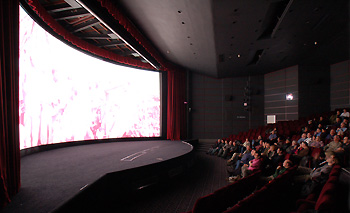 10:00 – 12:30 Cineramacana including a 10min digital
presentation on the curved screen, the odd surprise and the Academy of the
Widescreen Weekend presentation. 10:00 – 12:30 Cineramacana including a 10min digital
presentation on the curved screen, the odd surprise and the Academy of the
Widescreen Weekend presentation.One of the most popular events of the Widescreen Weekend and a great way to wake up on a Sunday morning, Cineramacana brings together all those little bits and pieces that lie around in people’s cupboards or on dusty shelves in archives and seldom see the light of a projector. Over the years there have been some magical discoveries and nobody knows what will be shown until the event itself. Even then there is the occasional surprise. And there will just be time for the traditional Audience on stage photograph of all the WW delegates. |
|
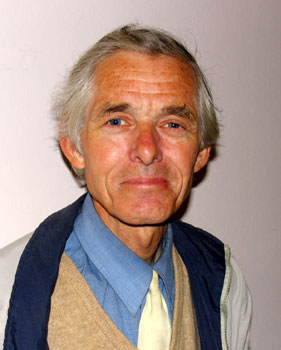 13:00 Grant Lobban on “blow ups" 13:00 Grant Lobban on “blow ups"Picture: Grant Lobban, supplied by Jim Slater, BKSTS Grant was BBC projectionist as far back as 1963, by coincidence when "Dr Who" began too (and Jim Slater was there, but nowhere near the projectors), and he remained at the BBC for the rest of his career, never enjoying the pleasures of a 'proper' cinema projection box, except on his days off. His recent 'Tales of a BBC Projectionist' published in CT, were enough to give any Health and Safety manager a heart-attack - just be glad that you weren't his boss back in those days! For as long as we can all remember Grant has been researching, writing and producing fascinating archival material about film-related topics for the BKSTS. He has been going to the cinema since he was a young lad, fascinated by all the large format and widescreen developments. He was the driving force behind many of the early film wall charts [Film Format Posters, ed], and his long series of articles on The Restoration Business, Showmanship, and The History of Colour Film have kept CT readers fascinated for years, as well as forming a magnificent reference source for any film history researchers. He seems to have spent his life fascinated by film, and there is little he doesn't know about any aspect of the business - he even won a BKSTS Film Quiz against some of the most knowledgeable people in the business. Grant never stops - the editor of CT is always glad to have a backlog of Grant's material ready for publication, and there are currently articles on lenses and other film-related developments waiting in my in-tray. Every film magazine editor should have a Grant Lobban, and you guys at the Widescreen Weekend are in for a treat! Jim Slater Managing Editor Cinema Technology Grant Lobban has also written the definitive story about the history of 70mm film "In the Splendour of 70mm". A story which Richard Vetter (of D-150 fame) has describes as "..the most accurate and comprehensive history of wide gauge film and 70mm....the finest contribution to wide gauge film that has ever been recorded!" Translated into German by Susanne Finken, Köln. |
|
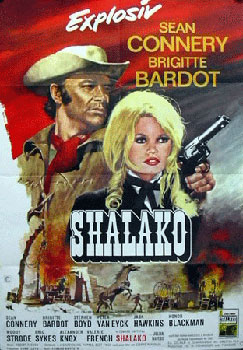 14:00 – 15:53 “Shalako” (1:53)
Filmed in:
35mm 4 perforations, 24 frames per second.
Principal photography in: Franscope. Presented:
On the flat screen in
Franscope
70mm with 6-track magnetic stereo.
Aspect ratio: 2,21:1. Country of origin: Germany. Production year:
1968.
German premiere: 06.09.1968. 14:00 – 15:53 “Shalako” (1:53)
Filmed in:
35mm 4 perforations, 24 frames per second.
Principal photography in: Franscope. Presented:
On the flat screen in
Franscope
70mm with 6-track magnetic stereo.
Aspect ratio: 2,21:1. Country of origin: Germany. Production year:
1968.
German premiere: 06.09.1968.
Poster is from first German release. Courtesy of Herbert Born Produced by Dimitri De Grunwald. Music by Robert Farnon. Cinematography by Ted Moore. Edited by Bill Blunden. Directed by Edward Dmytryk. Written by Louis L'Amour (novel) and Clarke Reynolds (screen story) Sean Connery (Moses Zebulon 'Shalako' Carlin), Brigitte Bardot (Countess Irina Lazaar), Stephen Boyd (Bosky Fulton), Jack Hawkins (Sir Charles Daggett), Honor Blackman (Lady Julia Daggett, Woody Strode (Chato (Apache chief) Hardened Indian fighter Shalako finds himself embroiled in a new kind of conflict when Apaches attack a hunting party of effete European aristocrats. The movie marks Sean Connery’s only appearance in a western. |
|
 16:00 Screen Talk: Q/A Euan Lloyd – producer of “Shalako”.
Born 6 December 1923, Rugby, England, UK (from
imdb.com) 16:00 Screen Talk: Q/A Euan Lloyd – producer of “Shalako”.
Born 6 December 1923, Rugby, England, UK (from
imdb.com)Image from NMM Mini bio written by Tony Earnshaw, NMM Euan Lloyd broke into films as a sixteen-year-old in 1939, working as a trainee cinema manager. After wartime service with the Royal Armoured Corps he returned to work in the motion picture industry, acting as a publicist for J. Arthur Rank’s Eagle-Lion Distributors on such British classics as Olivier’s "Henry V", "This Happy Breed" and "The Way Ahead". By 1952, having gained experience in all areas of film exhibition, distribution and publicity he joined Warwick Film Productions as personal assistant to Irving Allen and Cubby Broccoli. Warwick also provided Lloyd with his first opportunity to direct with the short "April" in Portugal. In 1960 Lloyd was associate producer, with Richard Widmark, of "The Secret Ways", and was appointed vice-president of Carl Foreman’s Highroad Productions, being closely involved with the making of "The Guns of Navarone" and "The Victors", among others. In 1967 he struck out as a fully independent producer with the Louis L’Amour western "Shalako", starring Sean Connery. Over the next ten years he turned out a string of movies, all geared towards the type of all-action entertainment Lloyd unsnobbishly liked. They included "Catlow", with Yul Brynner, and "Paper Tiger", with David Niven. His finest hour came in 1978 with the production of the mercenary epic "The Wild Geese". A star-studded adaptation of the bestseller by Daniel Carney, the film drew together the talents of Richard Burton, Roger Moore, Richard Harris and Hardy Kruger, director Andrew V. McLaglen and writer Reginald Rose of "12 Angry Men" fame. It was Lloyd’s masterpiece, and became his biggest hit. One of the most successful independent producers Britain has ever produced Euan Lloyd will reveal some of the sensitivities of working with mega stars, how films make their way from page to silver screen and why he was able to conclude so many deals on a smile and a handshake. We are delighted to welcome him back to the Bradford International Film Festival. Filmography (All credits as producer unless otherwise listed) 1956 April in Portugal (short) (& dir) 1959 Invitation to Monte Carlo (& dir, scr) 1961 The Secret Ways (assoc prod) 1965 Genghis Khan (assoc prod) 1966 The Poppy is also a Flower 1966 Murderer’s Row (co-prod) 1968 Shalako 1971 Catlow 1973 A Man Called Noon 1975 Paper Tiger 1978 The Wild Geese 1980 The Sea Wolves 1982 Who Dares Wins 1985 Wild Geese II |
|
 16:00 – 17:10 “Keepers
of the Frame” (1:10)
Filmed in:
16mm 1 perforation, 24 frames per second. Presented:
On the flat screen in 16mm
mono.
Aspect ratio: 1,33:1. Country of origin: USA. Production year:
1999. Premiere: 06.03.1999 (Santa Barbara International
Film Festival). 16:00 – 17:10 “Keepers
of the Frame” (1:10)
Filmed in:
16mm 1 perforation, 24 frames per second. Presented:
On the flat screen in 16mm
mono.
Aspect ratio: 1,33:1. Country of origin: USA. Production year:
1999. Premiere: 06.03.1999 (Santa Barbara International
Film Festival).
Produced by Randy Gitsch. Music by Steve Cornell. Cinematography by Rich Lerner & David McLaughlin. Edited by Roderick Kent. Directed by Mark McLaughlin. Written by Mark McLaughlin & Randy Gitsch. Starring Alan Alda, Roddy McDowall, Debbie Reynolds and Leonard Maltin The return engagement of "Keepers of the Frame". Filmmaker Randy Gitsch (on imdb.com) will be in-person and introduce his personal pristine 16mm print in the Cubby Broccoli Cinema on Sunday, 18 March 2007, at 16:00. See "Keepers of the Frame" press kit (in developement). |
|
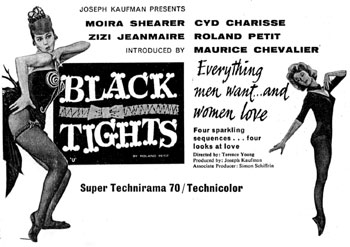 17:30 - 19:32 "Black Tights"/"Les Collants noirs" (2:09)
Filmed in: 35mm 8 perforations, 24 frames per second.
Principal photography in:
Technirama. Presented:
On the flat screen in Super Technirama 70mm with 6-track magnetic
stereo.
Aspect ratio: 2,21:1. Country of origin: France. Production year:
1962. English Premiere: 07.09.1961 Coliseum, London,
England. Preview title: "Un, Deux, Trois, Quatre!"
("One, Two, Three, Four!") 17:30 - 19:32 "Black Tights"/"Les Collants noirs" (2:09)
Filmed in: 35mm 8 perforations, 24 frames per second.
Principal photography in:
Technirama. Presented:
On the flat screen in Super Technirama 70mm with 6-track magnetic
stereo.
Aspect ratio: 2,21:1. Country of origin: France. Production year:
1962. English Premiere: 07.09.1961 Coliseum, London,
England. Preview title: "Un, Deux, Trois, Quatre!"
("One, Two, Three, Four!")Produced by Joeseph Kauffmann. Cinematography by Henri Alekan. Costume Design by Christian Dior, Yves Saint-Laurent and Clavê Wahkevitch. Musical director Roland Petit.Edited by Francoise Javet. Zizi Jeanmaire (Carmen), Cyd Charisse (The Widow), Roland Petit (Cyrano de Bergerac), Moira Shearer (Roxanne), Maurice Chevalier (Narrator) This film is a transposition of the most famous Roland Petit ballets. 1: The Diamond Cruncher: Les Halles (Central Food Market) of Paris in 1960. Surrounded by a lot of hooligans, passive admirers, “The Diamond Cruncher” (Zizi Jeanmaire) eats daily with their assistance, but she discover also love with a gentleman, strangely got involved in this peculiar environment. Song by Raymond Queneau. The best of Zizi Jeanmaire in a cheeky and relaxed style. 2: Cyrano de Bergerac: Paris in 1640. Cyrano de Bergerac (Roland Petit), a philosopher, duellist and versifier, lives at Hotel de Bourgogne and works hard to succeed in front of a musketeers audience. Her pretty cousin, Roxane (Moira Shearer), tenderly enamoured, waits in the audience near to Christian de Neuvillette (Georges Reich), his bashful lover. Cyrano passionately loves Roxane and, in the temporary camp of Arras, writes each morning love letters signed Christian. Unfortunately Christian dies and Roxane withdraws in a respectful retreat with the only visit of Cyrano during 15 years. But Cyrano’s enemies which don’t forgive his mischiefs and sarcasms, will injure him. He dies pronouncing the last words of a unfinished letter. 3 – A Merry Mourning: La Belle Epoque – A 1900 café. A pretty blonde woman (Cyd Charisse) “flirts” with one of his neighbours at table (Roland Petit), because his husband (Hans Van Manen) has refused to purchase her pretty clothes. The husband will fight a duel and die, and the pretty blonde, quickly consoled, will put on all pretty clothes. Typical sentimental dances of these times and the famous French Cancan. 4 – Carmen: Sevilla in 1830. Don Jose (Roland Petit) has made out the pretty gipsy Carmen (Zizi Jeanmaire) and search for her a full night; he discovers her in a gipsies cabaret. A full love night and day is enough to give to Carmen the power to reduce Don Jose to slavery. She imposes him to kill somebody. Hopeless, Don Jose knifes Carmen which dies in his arms. This translation © 20/02/2007 by Francois CARRIN. Translated from Internet Les Fiches du Cinéma. |
|
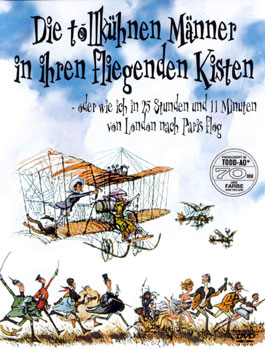 Produced and written by Jack Davies. Music by Ron Goodwin. Cinematography by Christopher Challis Edited by Anne V. Coates and Gordon Stone. Written and Directed by Ken Annakin. Stuart Whitman (Orvil Newton), Sarah Miles (Patricia Rawnsley), James Fox (Richard Mays), Alberto Sordi (Count Emilio Ponticelli), Robert Morley (Lord Rawnsley), Gert Fröbe (Colonel Manfred von Holstein), Jean-Pierre Cassel (Pierre Dubois), Irina Demick (Brigitte/Ingrid/Marlene/Françoise/Yvette/Betty), Eric Sykes (Courtney), Red Skelton (Neanderthal Man), Terry-Thomas (Sir Percy Ware-Armitage) and Benny Hill (Fire Chief Perkins) This is a film that created a genre, leading to "It’s a Mad Mad Mad Mad World", "Smokey and the Bandit" and "Wacky Races" to name just three imitators. It’s 1910 and the world is suddenly getting smaller. A newspaper baron sponsors a London to Paris air race and unleashes upon the world a wild range of aspiring but mad pilots all determined by fair means or foul to be the first to complete the flight in bizarre machines that may fly, but probably not for long. With a gem of a performance from Terry - Thomas, and cameos from Tony Hancock and Benny Hill, the humour is as strong as the mayhem. Surely time for a new print for this comedy classic. What is Todd-AO? "TODD-AO 70mm film, plus the TODD-AO special camera, plus the TODD-AO newly developed 6 channel high fidelity magnetic sound, plus the TODD-AO "all purpose" 70mm projector and the great arched TODD-AO screen equal the most revolutionary of all screen inventions, with clarity of perspective, detail and color reproduction never before achieved. As a result, with TODD-AO, audience participation now has its fullest and truest expression. Todd-AO is the dream of Michael Todd, plus the technical skills of the American Optical Company whose research staff headed by Dr. Brian O'Brien, jointly succeeded in developing "a motion picture system that would photograph action in a very wide angle....with one camera....on one strip of film....to be projected from a single projector....on a very wide screen....with a quality so perfect that the audience would be part of the action, not just passive spectators. |
|
Monday 19 March 2007 |
|
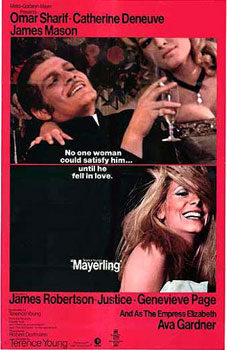 10:30 – 12:50 “Mayerling”
(2.20).
Filmed in: 35mm 4 perforations, 24 frames per second.
Principal photography in: Panavision. Presented:
On the flat screen in Panavision 70mm with 6-track magnetic stereo.
Aspect ratio: 2,21:1. Country of origin: England
& France. Production year:
1968.
English Premiere: 05.10.1968, Warner, London, England. 10:30 – 12:50 “Mayerling”
(2.20).
Filmed in: 35mm 4 perforations, 24 frames per second.
Principal photography in: Panavision. Presented:
On the flat screen in Panavision 70mm with 6-track magnetic stereo.
Aspect ratio: 2,21:1. Country of origin: England
& France. Production year:
1968.
English Premiere: 05.10.1968, Warner, London, England.Written and directed by Terence Young. Produced by Robert Dorfmann. Music by Francis Lai. Cinematography by Henri Alekan. Edited by Monique Bonnot. Omar Sharif (Archduke Rudolph), Catherine Deneuve (Maria Vetsera), James Mason (Emperor Franz Joseph), Ava Gardner (Empress Elizabeth), James Robertson Justice (Edward, Prince of Wales) |
|
|
Go: back
- top -
back issues
- news index Updated 22-01-25 |
|
